Vi chiedete perché le vostre email su WordPress non raggiungono le caselle di posta? Non siete soli!
Molti proprietari di siti web si trovano ad affrontare questo problema perché la maggior parte dei web host limita la funzione di posta PHP predefinita, facendo sì che le email vadano perse o finiscano nello spam.
È possibile correggere facilmente questo problema utilizzando il server SMTP di Gmail, una soluzione affidabile e gratuita che garantisce il corretto recapito delle email. L’abbiamo usato noi stessi e l’abbiamo trovato un’ottima scelta per i blogger, le piccole imprese e tutti coloro che vogliono inviare email senza problemi.
In questa guida vi mostreremo esattamente come impostare l’SMTP di Gmail in WordPress in modo che le vostre email raggiungano sempre le caselle di posta. ✅
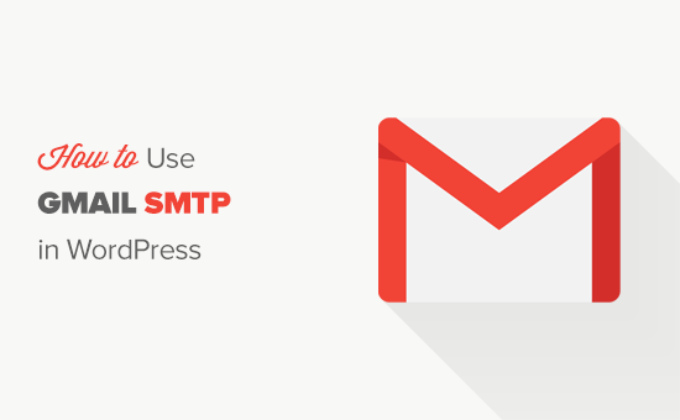
Perché e quando è necessario il server SMTP di Gmail per le e-mail di WordPress
Il vostro sito WordPress invia email per notificare la registrazione di nuovi utenti, la reimposta di password perse, gli aggiornamenti automatici e le notifiche dai moduli di contatto.
Per default, WordPress utilizza la funzione PHP mail per inviare notifiche via email. Tuttavia, questa funzione non funziona come previsto per diversi motivi.
La maggior parte delle società di hosting WordPress limita l’uso di questa funzione per evitare abusi e spam.
I filtri antispam dei più diffusi provider di servizi di posta elettronica selezionano le email in arrivo per verificare se sono state inviate da server di posta autentici. A volte, le email predefinite di WordPress potrebbero non superare questo controllo e non arrivare nemmeno nella cartella spam.
SMTP (Simple Mail Transfer Protocol) è lo standard industriale per l’invio di email. A differenza della funzione mail di PHP, SMTP utilizza un’autenticazione adeguata, che aumenta la deliverability delle email.
Gmail fornisce un servizio SMTP che potete utilizzare per inviare email dal vostro sito WordPress. I loro server sono l’opzione migliore se volete inviare email di notifica di WordPress solo a voi stessi e a pochi utenti del vostro sito.
Tuttavia, nel caso in cui vogliate inviare email di newsletter o avere un negozio online.
Allora dovreste utilizzare un fornitore di servizi di invio di email di massa, come Constant Contact, Brevo (ex Sendinblue) o Mailgun.
Servizio SMTP Gmail gratuito o a pagamento per WordPress
È possibile utilizzare l’account Gmail gratuito per inviare email su WordPress. Tuttavia, per una migliore deliverability, vi consigliamo di utilizzare lo spazio Google Workspace a pagamento.
Con Google Workspace, si ottiene un proprio indirizzo email professionale brandizzato, come ad esempio name@yoursite.com.
Google Workspace richiede l’aggiunta di record MX al proprio dominio. In questo modo le email sembreranno provenire dal vostro dominio, il che contribuisce ad aumentare l’autenticità e a garantire una migliore deliverability.
Se preferite le istruzioni scritte, continuate a leggere. Ecco una rapida panoramica di tutti i metodi di cui ci occuperemo in questa guida:
Pronti? Iniziamo.
Come inviare e-mail di WordPress utilizzando il server SMTP di Gmail
Se decidete di utilizzare Google Workspace, dovete innanzitutto impostare il vostro dominio per lavorare con Google Apps. Abbiamo un tutorial passo passo su come impostare un indirizzo e-mail professionale con Google Workspace.
Il resto delle istruzioni è identico, sia che si utilizzi un account Gmail a pagamento che uno gratuito.
WP Mail SMTP è il miglior plugin SMTP per WordPress sul mercato. Permette di utilizzare facilmente qualsiasi server SMTP per inviare email WordPress con una deliverability superiore.
Nota: noi stessi utilizziamo WP Mail SMTP sul nostro sito e abbiamo visto come ci aiuta a garantire che tutte le nostre email raggiungano le caselle di posta degli utenti e non la cartella dello spam. Leggete la nostra recensione completa di WP Mail SMTP per saperne di più sulle sue caratteristiche!
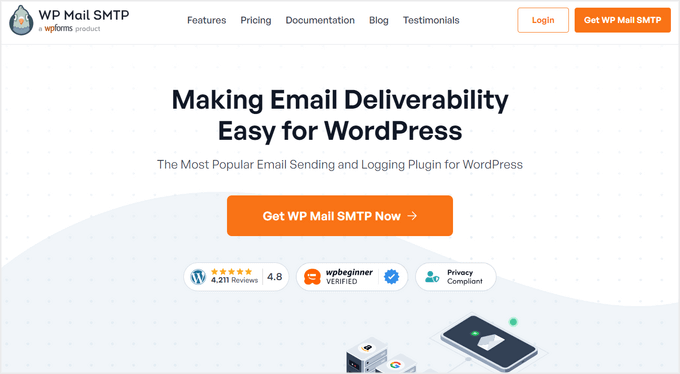
Quindi, installiamo e attiviamo il plugin WP Mail SMTP. Per maggiori dettagli, consultate la nostra guida passo passo su come installare un plugin di WordPress.
Sebbene esista una versione gratuita, vi consigliamo di acquistare la versione a pagamento, chiamata WP Mail SMTP Pro, che vi dà accesso a un supporto premium, a un maggior numero di mailer e a una configurazione in guanti bianchi da parte di uno dei loro esperti.
Dopo l’attivazione, è necessario visitare la sezione Impostazioni ” WP Mail SMTP per configurare le impostazioni del plugin. Quindi, è sufficiente inserire la chiave di licenza e fare clic sul pulsante “Verifica chiave”. La chiave si trova nell’area del proprio account WP Mail SMTP.
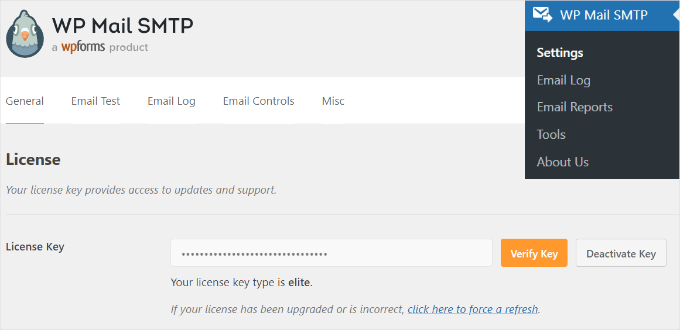
Nella scheda “Impostazioni generali”, è necessario assicurarsi di utilizzare il proprio indirizzo email di Gmail nel campo “Da email”.
Successivamente, è necessario fornire il nome del mittente.
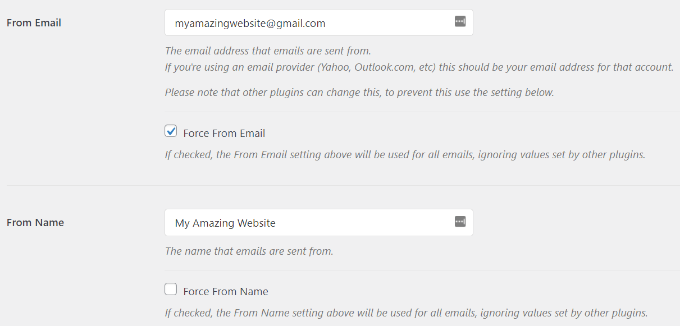
Il plugin WP Mail SMTP offre 3 modi per collegare il vostro sito WordPress ai server Gmail:
- Il primo metodo utilizza un’installazione con un clic, che è la più semplice e adatta ai principianti, ma è disponibile solo per gli utenti di plugin premium.
- Il secondo metodo utilizza l’autenticazione OAuth. Questo metodo è sicuro e non richiede un plugin richiesto.
- Il terzo metodo consiste nel configurare manualmente le impostazioni SMTP di Gmail. In generale, non consigliamo questo metodo perché è meno sicuro.
Tenendo presente questo, impostiamo WordPress in modo che utilizzi Gmail SMTP per l’invio di email.
Metodo 1: Impostazione di Gmail per l’invio di email di WordPress tramite l’installazione con un clic
Questo metodo è il più semplice e veloce per tutti, il che significa che può aiutarvi a salvare tempo e confusione.
Dopo aver installato e attivato il plugin WP Mail SMTP, andiamo su WP Mail SMTP ” Impostazioni e assicuriamoci di essere nella scheda “Generale”.
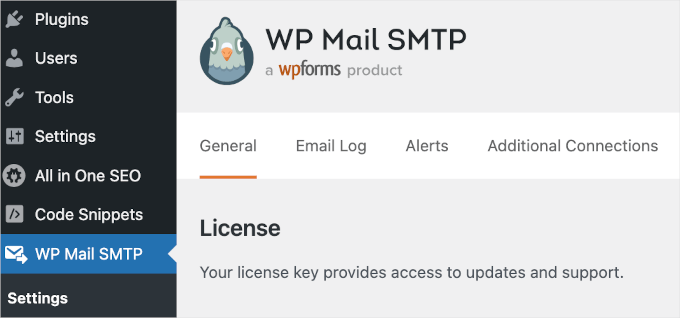
Quindi, dovrete scegliere “Google / Gmail” nella sezione “Mailer”.
In questo modo si potrà utilizzare l’opzione “Configurazione con un clic”.
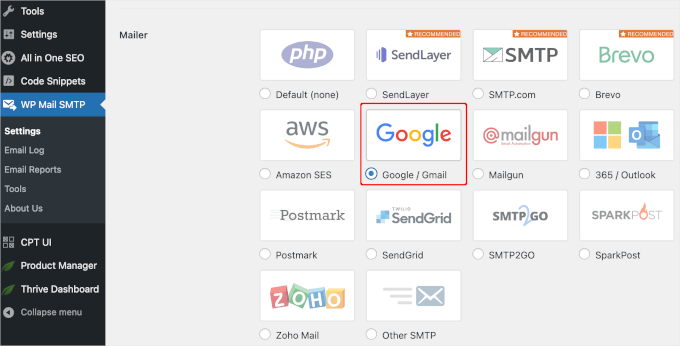
Fatto questo, il passo successivo è quello di autorizzare il vostro account Google.
Nella schermata, sotto la voce “Mailer”, è presente la sezione “Google / Gmail”. Fate clic sull’interruttore per attivare la caratteristica di installazione con un solo clic.
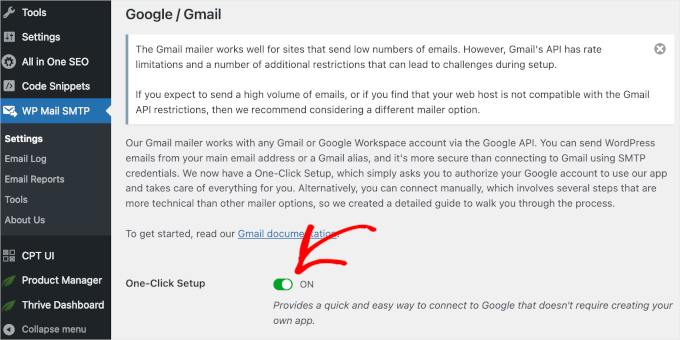
A questo punto, potrebbe apparire una notifiche che indica la necessità di salvare le modifiche per continuare il processo di autorizzazione.
Quindi, facciamo clic sul pulsante “Salva impostazioni”.
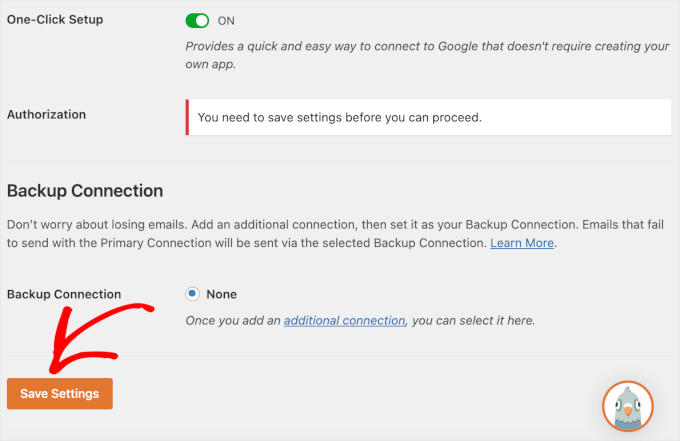
Dopodiché, si dovrebbe essere in grado di continuare il processo.
Verrà richiesto di accedere al proprio account Google. Fare clic sul pulsante “Accedi a Google” e scegliere un account.
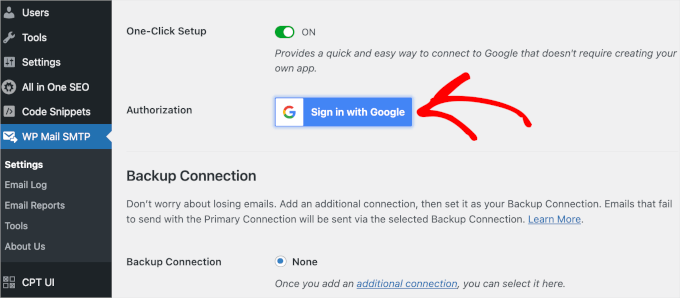
Google chiederà quindi l’autorizzazione a WP Mail SMTP per l’invio di email a vostro nome.
È possibile fare clic su “Consenti” per continuare.
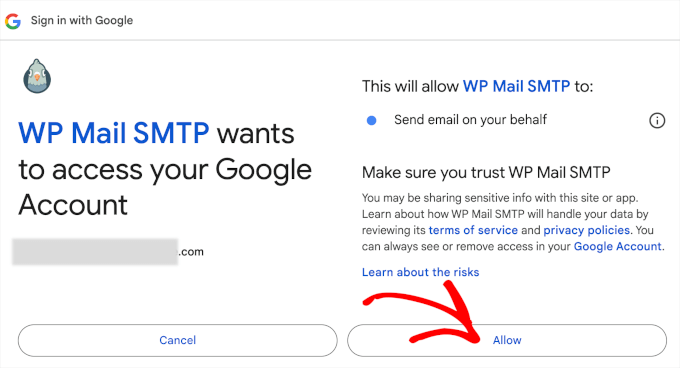
Facendo clic sul pulsante, si verrà reindirizzati alla scheda “Generale” di WP Mail SMTP nell’area di amministrazione di WordPress.
Da qui, si dovrà scorrere giù fino alla sezione “Autorizzazione” per vedere se l’account Gmail impostato è stato collegato con successo.
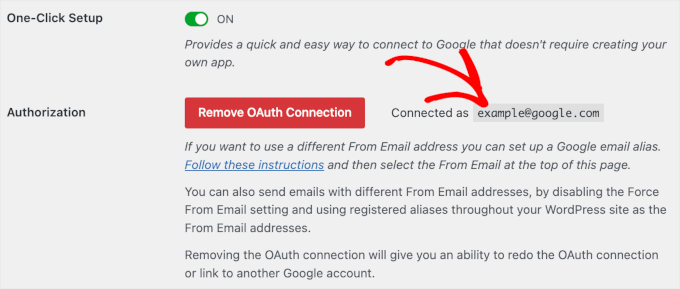
Ecco fatto! Avete collegato con successo il vostro account Gmail a WP Mail SMTP utilizzando il metodo di configurazione con un clic!
Metodo 2: impostazione di Gmail per l’invio di email di WordPress tramite il protocollo OAuth
Questo metodo è un’ottima opzione se si utilizza una versione gratuita del plugin WP Mail SMTP. È sicuro e, una volta impostato, non dovrete più farlo.
È necessario iniziare selezionando “Google/Gmail” come mailer.
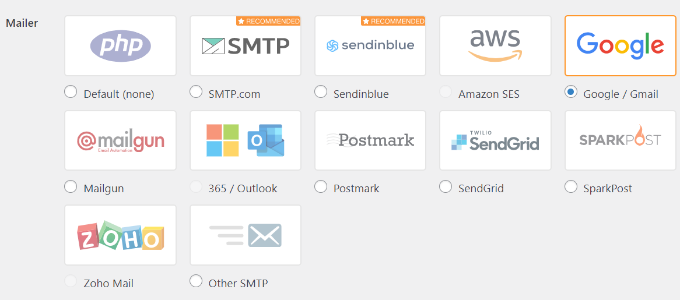
Successivamente, si vedranno tre campi da riempire quando si scorre verso il basso.
Basta compilare i campi “Client ID”, “Client Secret” e“Authorized Redirect URI“.
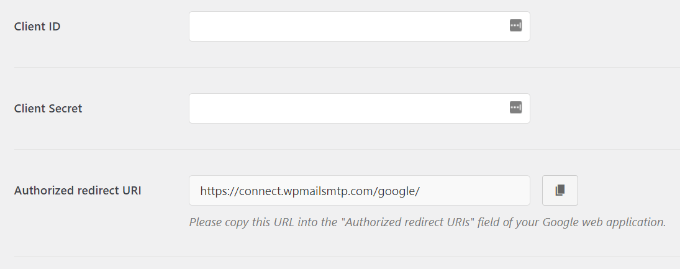
Impostiamo questi campi.
Creare un’app e generare chiavi API per Gmail
Per iniziare, basta visitare il sito web di Google Cloud Platform e fare clic su “Il mio primo progetto” in alto.
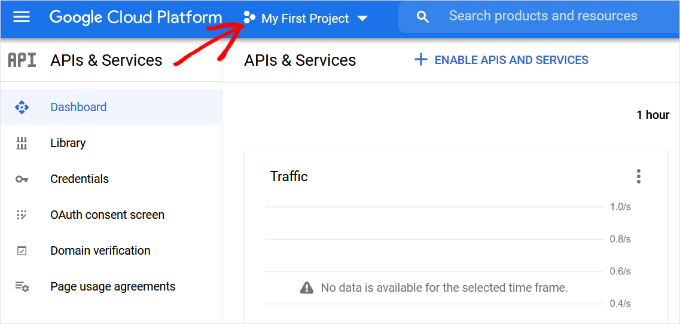
Si aprirà una piccola finestra a comparsa in cui è possibile selezionare i progetti.
Fare clic sull’opzione “Nuovo progetto”.
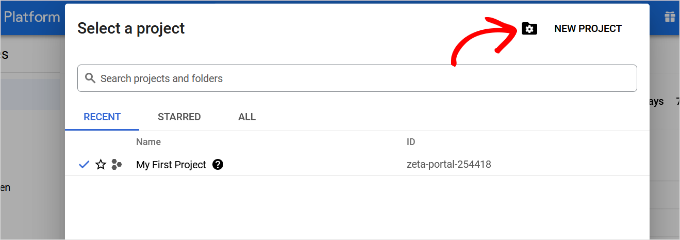
Nella schermata successiva, vi verrà chiesto di fornire un nome al vostro progetto.
Si consiglia di assegnargli un nome memorabile, in modo da poterlo riconoscere facilmente in futuro.
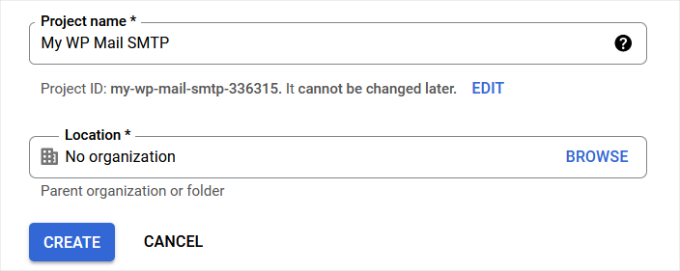
Quindi, facciamo clic sul pulsante “Crea” per continuare.
La console per sviluppatori creerà ora il progetto e lo porterà alla sua Bacheca.
Google offre agli sviluppatori l’accesso a molte delle sue API e servizi. È necessario abilitare le API di cui si ha bisogno per questo progetto.
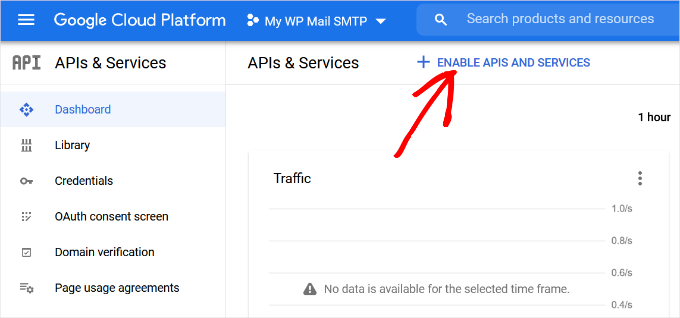
È sufficiente fare clic sul pulsante “Abilita API e servizi” per continuare.
Si accede così alla pagina della libreria delle API.
Da qui, è possibile digitare Gmail nella casella di ricerca per trovare rapidamente l’API Gmail e fare clic per selezionarla.

Ora viene presentata una panoramica dell’API e delle sue funzioni.
È sufficiente fare clic sul pulsante “Abilita” per continuare.
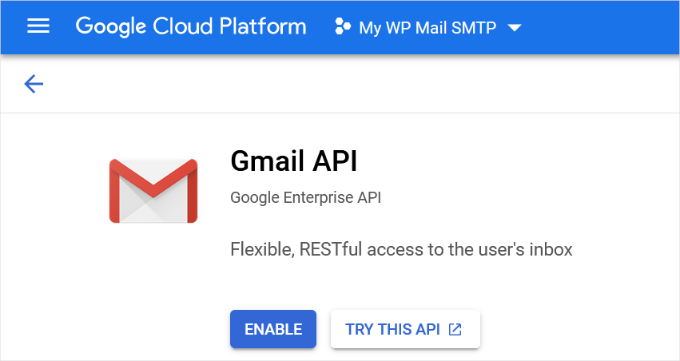
Ora che l’API è abilitata, il passo successivo è creare le credenziali da utilizzare nelle impostazioni del plugin WP Mail SMTP.
Per continuare, fare clic sul pulsante “+ Crea credenziali” e selezionare l’opzione “Aiutami a scegliere” dal menu a discesa.
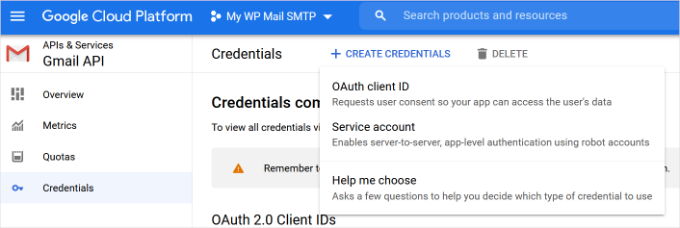
Nella schermata successiva, vi verrà chiesto quale API volete usare.
Selezionate “Gmail API” dal menu a discesa di “Quale API state usando?”.
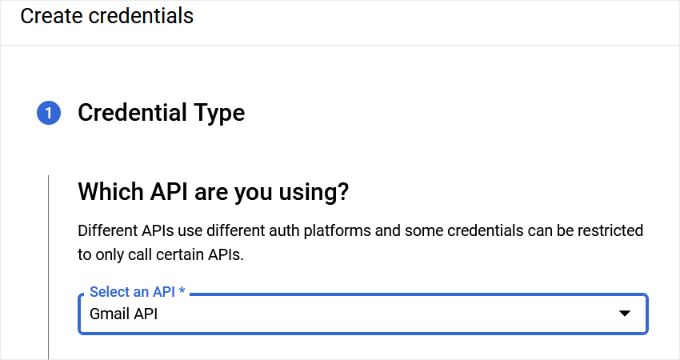
Successivamente, nel campo “A quali dati si accede?” si sceglierà “Dati utente”.
Fatto questo, procedete facendo clic sul pulsante “Avanti”.
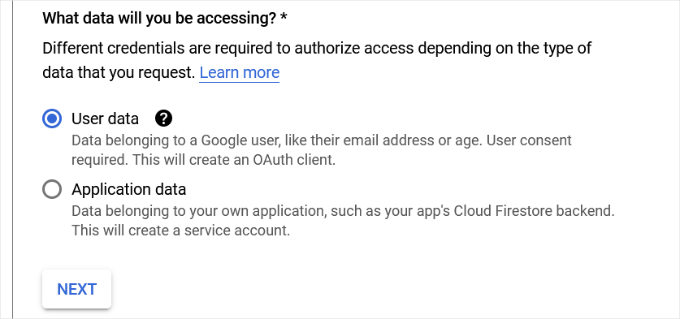
A questo punto è necessario inserire le informazioni della propria applicazione.
Si può iniziare dando un nome alla propria app, selezionando l’indirizzo e-mail fornito e aggiungendo un logo dell’app, se lo si desidera.
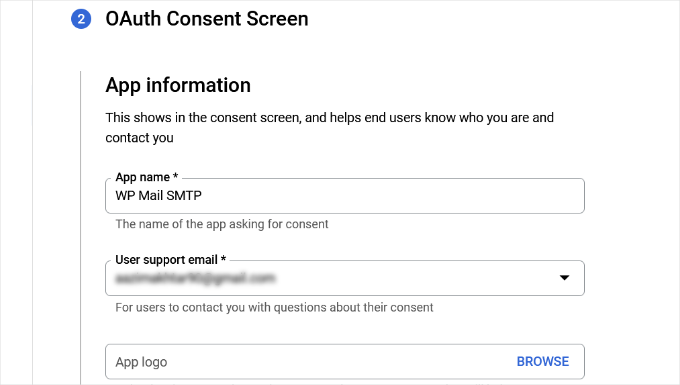
Da lì, dovrete scorrere verso il basso e inserire le informazioni di contatto di uno sviluppatore.
Una volta inserito l’indirizzo e-mail, è sufficiente fare clic sul pulsante “Salva e continua”.
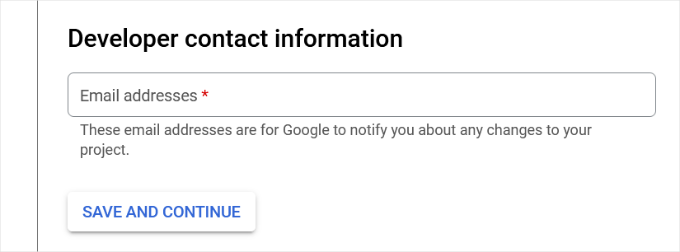
Nella schermata successiva, è possibile configurare gli ‘Scopes’ per Gmail API. Si tratta di un passaggio facoltativo, che per ora si può saltare.
È sufficiente scorrere fino alla fine della pagina e fare clic sul pulsante “Salva e continua”.
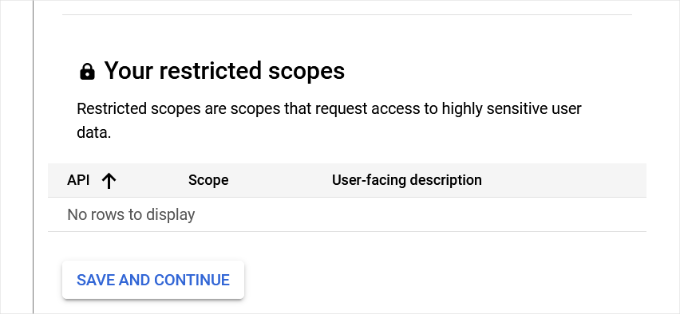
Quindi, inserire i dettagli per la sezione “OAuth Client ID”.
Si può iniziare scegliendo “Applicazione web” come “Tipo di applicazione” dal menu a discesa e inserendo un nome.
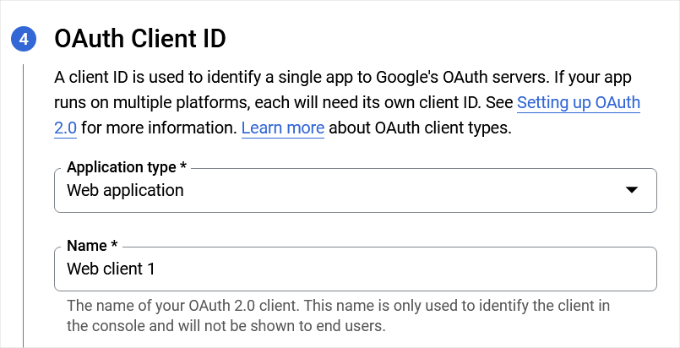
Scorrendo verso il basso, si vedranno le opzioni relative alle origini “JavaScript autorizzate”. Si può saltare questa opzione e passare a “URI di reindirizzamento autorizzati”.
Fare clic sul pulsante “+ Aggiungi URL” in “URI di reindirizzamento autore” e inserire https://connect.wpmailsmtp.com/google/ nel campo "URI".
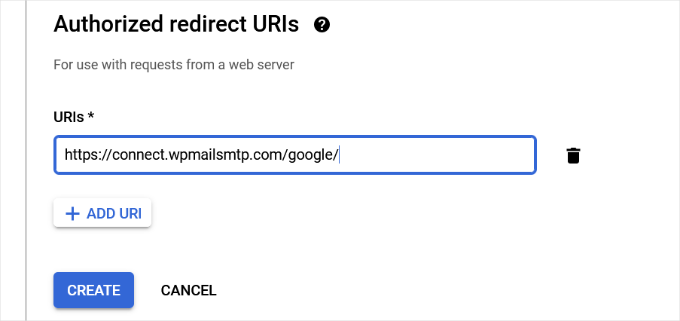
Una volta inserito l’URL, è sufficiente fare clic sul pulsante “Crea”.
Successivamente, vedrete le vostre credenziali nell’area “Le vostre credenziali”.
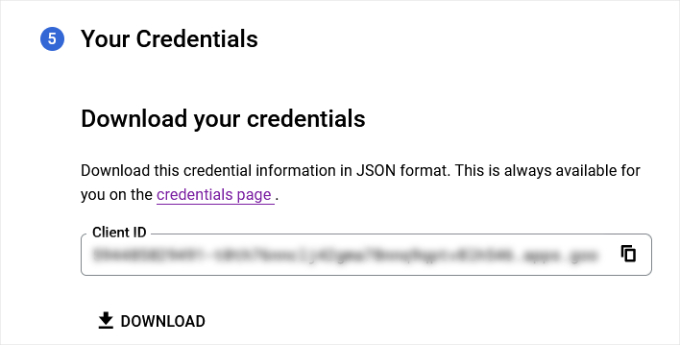
Fate clic sul pulsante “Fatto” in basso per andare avanti.
A questo punto si accede alla pagina delle credenziali del progetto.
In questa pagina sono elencate le credenziali create di recente. Per continuare, è necessario fare clic sull’icona di modifica accanto alle credenziali.
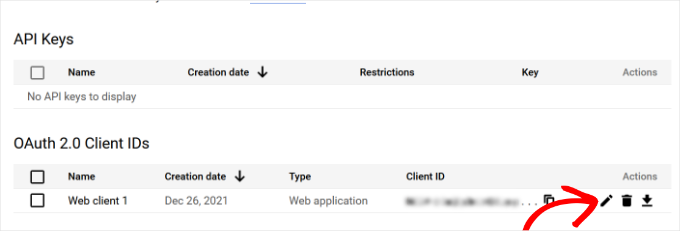
In questo modo si accede alla pagina di modifica delle credenziali, dove è possibile vedere il segreto del cliente e l’ID del cliente.
È sufficiente copiare e incollare la chiave nella pagina delle impostazioni del plugin.
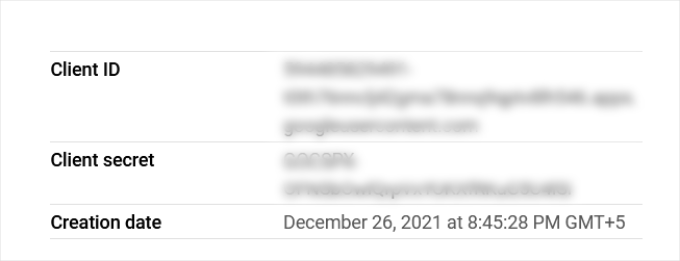
Una volta fatto, si può restituire la pagina delle impostazioni del plugin nell’area di amministrazione di WordPress.
Ora che si dispone dell’ID cliente e delle chiavi segrete del cliente, è necessario fare clic sul pulsante “Salva impostazioni” per continuare.
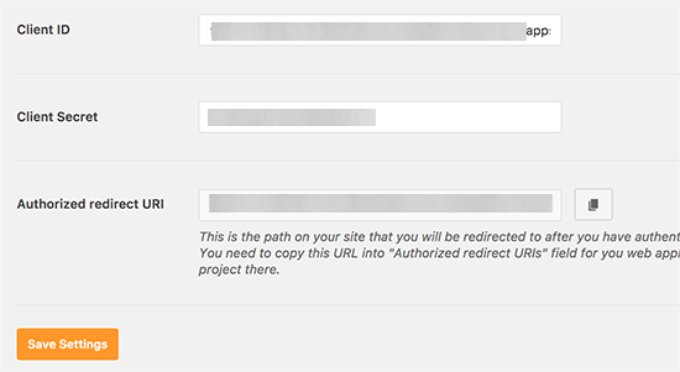
Il plugin memorizzerà le impostazioni e ricaricherà la pagina.
Successivamente, è necessario scorrere fino alla fine della pagina delle impostazioni e fare clic sul pulsante “Consenti al plugin di inviare e-mail utilizzando il tuo account Google”.
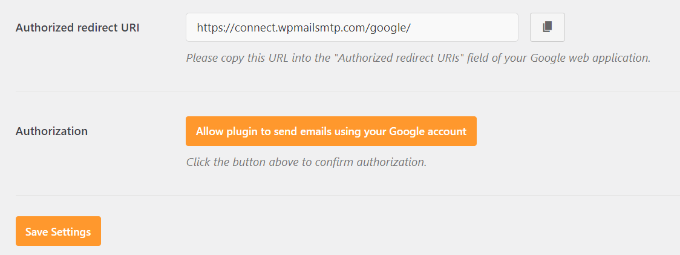
In questo modo si accede al proprio account Google.
Poi vi verrà chiesto di autorizzare il sito web a inviare e-mail per vostro conto.
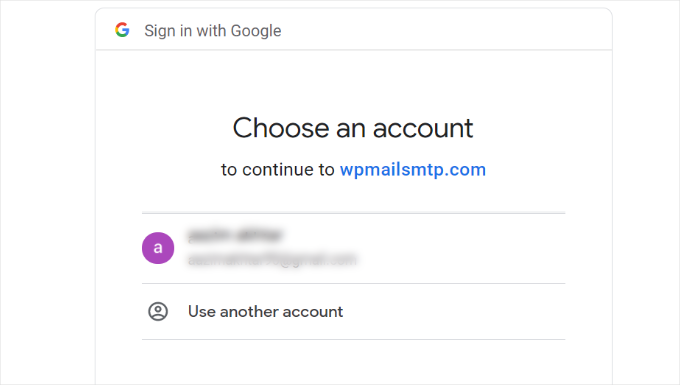
È sufficiente selezionare l’account Gmail e dare l’autorizzazione a collegare il progetto Google API.
Successivamente, si verrà reindirizzati al proprio sito web, dove verrà visualizzato un messaggio di successo.
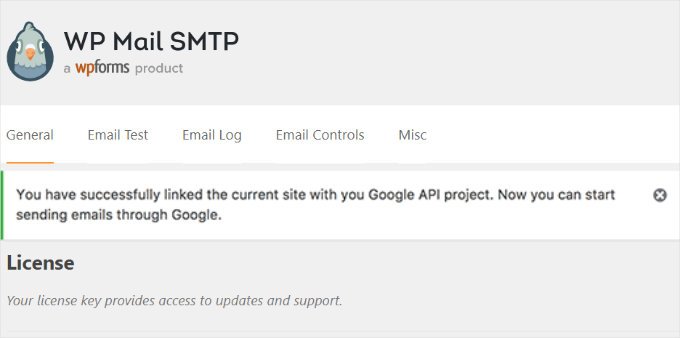
Metodo 3: impostazione di Gmail SMTP come mittente SMTP
Questo metodo consente di collegarsi manualmente ai server SMTP di Gmail per inviare le email di WordPress.
Per prima cosa, è necessario andare su Impostazioni ” WP Mail SMTP dall’area di amministrazione di WordPress per configurare le impostazioni del plugin.
Da qui, si può iniziare fornendo l’indirizzo Gmail che si desidera utilizzare nel campo “Da email” e il proprio nome nel campo “Da nome”.

Quindi, selezioniamo “Altro SMTP” come mailer.
Inoltre, occorre selezionare la casella accanto al percorso di restituzione.
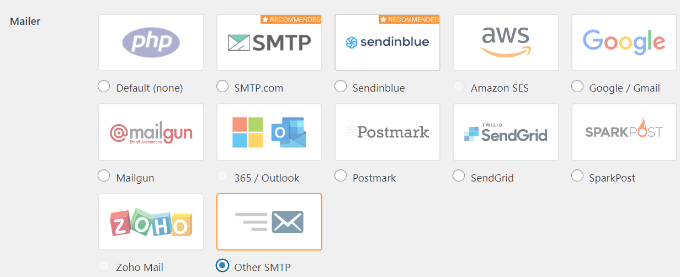
Successivamente, si può scendere fino alla sezione “Altri SMTP”.
Qui si configurano altre impostazioni per la connessione ai server SMTP di Gmail.
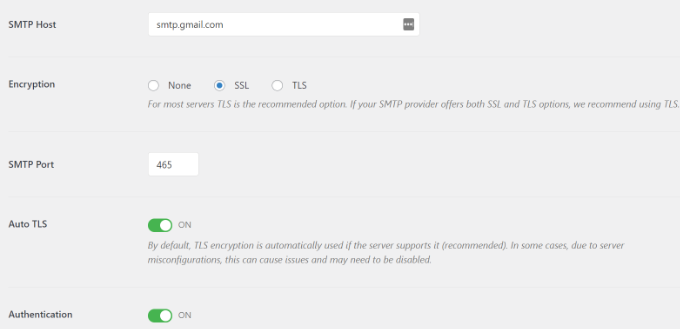
Ecco la configurazione esatta da aggiungere alle impostazioni del plugin:
- Host SMTP: smtp.gmail.com
- Crittografia: Utilizzare la crittografia SSL
- Porta SMTP: 465 (dovrebbe apparire automaticamente quando si seleziona la crittografia SSL)
- Auto TLS: Disattiva TLS
- Autenticazione: Attivare l’autenticazione
- Nome utente SMTP: l’indirizzo Gmail completo, ad esempio john.smith@yourdomain.com o john.smith@gmail.com.
- Password SMTP: password dell’account Gmail.
Una volta terminato, fare clic sul pulsante “Salva modifiche” per memorizzare le impostazioni.
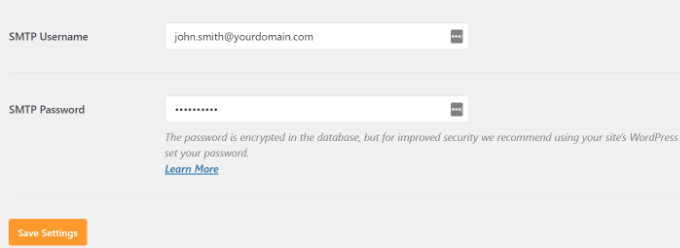
Questo è tutto; avete impostato con successo WP Mail SMTP per utilizzare i server SMTP di Gmail.
Verifica delle impostazioni SMTP di WP Mail
Il plugin WP Mail SMTP consente di testare le impostazioni della posta elettronica per assicurarsi che tutto funzioni correttamente.
È necessario navigare in Impostazioni ” WP Mail SMTP e cliccare sulla scheda ‘Test email’.
A questo punto, è sufficiente indicare un indirizzo email accessibile nel campo “Invia a” e fare clic sul pulsante “Invia e-mail”.
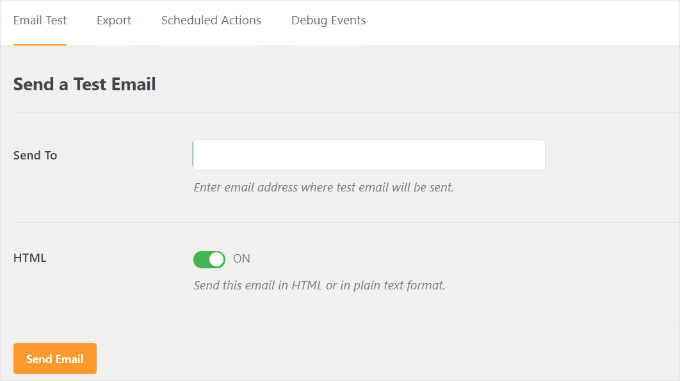
Dovrebbe essere visualizzato un messaggio di successo.
Per verificarlo, si può controllare la posta in arrivo per vedere un messaggio con l’argomento “WP Mail SMTP: Test Email to…”.
Questo è tutto; avete impostato con successo il vostro sito WordPress per inviare e-mail utilizzando i server SMTP di Gmail.
Ottenere di più con WP Mail SMTP Pro
Se volete ancora più funzionalità, dovreste provare WP Mail SMTP Pro. Con la versione Pro del plugin, è possibile connettersi con:
- Spazio di lavoro/Gmail di Google
- Amazon SES
- Pistola postale
- Office 365 / Outlook.com
- InviaGrid
- E altro ancora
Avrete anche caratteristiche aggiuntive come gli accedi alle email, la possibilità di regolare o controllare le notifiche inviate dal vostro sito WordPress e altro ancora.
Risoluzione dei problemi di Gmail SMTP non funzionante
Abbiamo riscontrato alcuni problemi nell’utilizzo di Gmail SMTP con alcune configurazioni di hosting condiviso.
Per correggere il problema SMTP di Gmail, è possibile seguire le seguenti indicazioni:
Per prima cosa, è necessario effettuare l’accesso al proprio account cPanel. Da qui, troverete il pulsante “+ Crea” sulla pagina degli account email.

È sufficiente creare un account email in corrispondenza dell’indirizzo email di Google Apps.
Creando l’account di posta elettronica, si rende noto al server di hosting un indirizzo di posta elettronica che dovrebbe inviare le e-mail. Questo passaggio è un workaround per convincere il server che si stanno inviando e-mail attraverso di esso, anche se si intende utilizzare il server SMTP di Gmail.
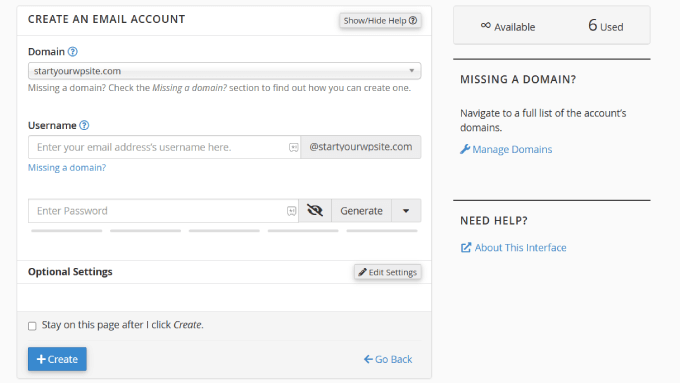
Questo può sembrare strano perché non si utilizza il server per le email. In pratica, inganna il server facendo credere che si stia inviando l’email attraverso il server.
Dal vostro account cPanel, andate ai record MX e cambiate il routing MX da automatico a remoto. Si noti che potrebbe essere un po’ difficile da trovare, poiché ogni host ha un’interfaccia cPanel personalizzata.
Poi, dovrete cercare un piccolo link accanto a MX che dice “Email Routing: Mail Exchanger remoto”.
Dopodiché, potete accedere nuovamente al vostro sito WordPress e inviare un’email di prova. Per maggiori dettagli, potete seguire la nostra guida su come modificare i record MX per il vostro sito WordPress in base al vostro servizio di hosting.
Video tutorial
🎥 Guardate il nostro video tutorial passo-passo qui sotto per configurare rapidamente Gmail SMTP in WordPress e assicurarvi che le vostre email vengano consegnate in modo affidabile.
Basta hit play e seguirci!
Speriamo che questo articolo vi abbia aiutato a imparare come inviare email in WordPress utilizzando il server SMTP di Gmail. Potreste anche voler consultare i nostri consigli degli esperti per la risoluzione dei problemi quando il modulo di WordPress non funziona e la nostra guida su come esportare i moduli di WordPress in CSV ed Excel.
Se questo articolo vi è piaciuto, iscrivetevi al nostro canale YouTube per le esercitazioni video su WordPress. Potete trovarci anche su Twitter e Facebook.





David
Hi, I used this tutorial last year to install and configure the Gmail SMTP plugin. Until very recently, the Gmail SMTP plugin in conjunction with my website’s contact form worked perfectly. But I tested my website’s contact form today, and I got the following fatal-error message:
Fatal error: Uncaught exception ‘Google_Auth_Exception’ with message ‘Error refreshing the OAuth2 token, message: ‘{ “error” : “invalid_grant” }”
I don’t have a clue what that means. I get the same fatal-error message when I use the plugin to send a test message at Gmail SMTP plugin>Settings>Test email.
I haven’t changed any of the plugin settings since I first installed it a year ago, and I haven’t done anything new with my Google Console account either. I’m using the most recent version of the Gmail SMTP plugin, and also the newest version of WordPress.
Any ideas or suggestions?
Thanks!
WPBeginner Support
Hey David,
It seems like your Oauth2 token has expired. Try following the tutorial again from the beginning to set it up again.
Admin
Ehsan
Thank U very much – one of my problem was this “my emails goes to spam folder”
with this service(Method 1) Now It’s great – of course after 14 days you must pay for that but still it’s prefect
I have question;
Can I send 100 Emails like newsletter for my customer is it OK for Google!?
I afraid my Emails after it goes to spam folder again
Sharon
I did everything as described, but the contact form on my website still does not work.
Adondriel
Hey, add a thing at the end for the troubleshooting thing: “Check with your website host and verify that they do not block outgoing requests by default.” I know 1. GoDaddy does this, and won’t let you unblock. and 2. Namecheap also blocks by default but you just gotta contact support, give em your info and ask em to unblock port 587 and boom, it’ll all work again.
Lucas
You save my life!
Tks!
adam
i keep getting a Error: redirect_uri_mismatch when i press ‘grant permission’. It’s driving me nuts as I can’t work out what is wrong? Everything seems to match.
Adam
Grzegorz
Same here. i get redirect_uri_mismatch
Macky
This video has been a fantastic help.
I’m a complete WordPress beginner.The step-by step instructions are very easy to follow. Now my emails are working perfectly!! Plus I also learnt how to insert headers & footers with ease.
Thanks once again!!
WPBeginner Support
Hi Macky,
We are glad you found the video helpful. You may also want to subscribe to our YouTube Channel for WordPress video tutorials.
Admin
Fabio
Your tutorial saved my site! Thank you very much mate!
Maggie Z
A follow-up question – because of the login conflict issue, I was also considering using WP Mail SMTP. However, many users on the support forum for that plugin express concern that the password for the email account is visible on the admin page in plain text.
I have a firewall set up that prevents non-admins from getting in to the back end, so is there any real security concern regarding the password showing in plain text? Any advice much appreciated!!!
Maggie Z
After troubleshooting quite a bit, I finally relented and went with WP Mail SMTP, which requires the “allow less secure apps” solution – a tech support person at G Suite told me that it was safe, and it seems like the only way to go for my particular setup. Appears to be working now. Thanks for the incredibly clear instructions!!! I am now a firm fan of this site.
Maggie Zellner
The video is fantastic, and the plugin installed perfectly. Unfortunately I didn’t realize until after I went through the whole process (because I didn’t read the documentation on the plugin carefully), the Gmail SMTP plugin eliminates the need for users to log in, and therefore it interfered with the login process that we have instituted for paid members on our website (which we manage through a plugin called PaidMembershipsPro).
Is there any way to disable that aspect of this plugin, so I can send all email via our Gmail account, but can still have users log in and out?
Eric
Great article! However, I am unclear on something when using WordPress for sending newsletters. What is the difference between those mass emailing service providers (mailgun & Sendgrid) and using Google Apps for work SMTP?
Can’t we use Google Apps for work to send newsletters just as well?
WPBeginner Support
with Google Apps for Work, you can only send an email to 500 recipients max (for paid business accounts). You cannot use it for newsletters.
Admin
Eric
Thanks so much for your response! With Google Apps for Work only limiting to 500 recipients, then I suppose it would work if we sent it to 500 or less people.
My next question, is it max to send all at one time or per day? If we throttle it to only send out a few per minute, do you know if it would allow it to send thousands within a few hours?
Heather
Thank you so much! This was so helpful!
zim ejin
Hi, this was very informative thank you for posting. however i have a website hosted on aws ec2, and route53 for dns. i tried the secure configuration. it didn’t work. Is there a special configuration for self hosted websites on aws ec2/route53. btw : i don’t have a cpanel installed.
Lanrz
After granting access and clicking on the allow button, I was not being redirected back to wordpress and the SMTP status is still not connected.
Any advice on how I should go about doing it?
Thanks!
Nathalie
Doesn’t work: test email retuens Connection: opening to smtp.gmail.com:587, timeout=300, options=array ( ‘ssl’ => array ( ‘verify_peer’ => false, ‘verify_peer_name’ => false, ‘allow_self_signed’ => true, ),)
I checked Email Routing -> Remote Mail Exchanger but it didn’t help
Raph Divine
Thanks for the write-up. It really helped me! 5stars!
Real Name
This guide worked wonderfully until my server stopped sending emails and I can’t get it to work again. The “Test Email” tab doesn’t make it clear if the email has successfully sent or not since it just spews out 52 lines that don’t mean much to me. :/
Boro
Amazing Tutorial !!!!
Thank you
peter
Ok, so I have followed the OAuth instructions and my SMPT status button has gone green. However, whether through test email or my site, I can not send an email through the contact us form (pluggin contact form builder by web Durado). The hanging message say waiting for and eventually I get a 405 error notice.
Any thoughts.
Thomas
Hoping you can help me?
I tried setting up method 1 using gmail and I got the ‘green light’ from wordpress however when testing the email I receive the following error message after waiting 1 minute for it to send:
Connection: opening to smtp.gmail.com:587, timeout=300, options=array ()
Any ideas on how to fix this?
Very best,
Tom
Fernando Santos
This tutorial is awesome!
I have one question, though. I directed the contact form messages to a gmail group email address, but, for some reason, the messages aren’t being delivered. When I direct to a “real” e-mail address like the messages are normally delivered.
I would really appreciate if someone could give me a hand figuring out why this happens.
Thank you!!!
Paul
+1 for this question. Have exactly the same question as wish to use our info@.. address
Andres
Thanks guys for such useful article. I followed all the steps and was able to configure the email correctly. However, when I receive the email from mydomain.com address (sent by wordpress after purchasing a product), the user avatar (gmail picture) doesn’t appear even though mydomain.com has a picture already.
In fact, if I send an email directly from mydomain.com account via google for work, the receiver is able to see the image right away, but it’s not the case if the email is sent via wordpress.
Do you have any suggestions? Thanks a lot, and keep rocking!
Sahar
Thanks for this helpful information. You really helped me out in setting this up, and I appreciate you taking the time to create this useful information!
WPBeginner Support
Glad you found it helpful.
Admin
lokesh kumar CL
What is origin URI of the client application. its not accepting website URL ….please help me out
Susan
Excellent instructions and thanks for walking me through setting this up. I did try the MX record change but no luck there either.
I get a 405 Not allowed message when I try to send an email.
I am hosted by Bluehost and am using the DIVI theme.
If anyone has any ideas I would be very grateful.
Leista
Hello, having a similar issue. Getting a 405 error, and also hosted on Bluehost. By any chance, were you able to fix the problem? Thanks.
JDC
I had the same problem with bluehost. But this gave me the solution.
I uninstalled any extra plugin for mail, including smtp mailer or gmail smtp plugin and just used a random address like mynewaddress@example.com (replace example.com with your own domain name) and it worked. I sent an email to my gmail account I it passes all the filters. It seems that BlueHost validates the address if it is comming from the server that hosts that domain. In gmail you usually get a warning that says that this email might not have being validated, but my email are comming fine with custom wordpress email functions. No extra plugin needed.
Prashant Bhandarkar
Thank you so much. This was of great help. God Bless you!
Karmen
Awesome tutorial!!!
Louise
I have this working brilliantly with a Google apps for work account for a woocommerce solution on wordpress, thank you.
Should this work if I use a Google group mail instead of an account?
Thanks very much.
Brian Treiber
I am not using Google apps for work, I have everything set up and connected. I tried to send a test email however I get a 405 not allowed error. I went into my cpanel and changed the mx records to the recommended” remote.” Still can’t send. Does this mean I need to use the less secure method?
Jason North
I’m getting this error when I try to activate the plugin:
Plugin could not be activated because it triggered a fatal error. Parse error: syntax error, unexpected T_FUNCTION, expecting ‘)’ in /home3/north23/public_html/forcebrain/wp-content/plugins/gmail-smtp/google-api-php-client/src/Google/autoload.php on line 19
genie
Hello, I use gmail-smtp plugin but it conflict with ultimate membership. Could you help me ?
I try another wp mail smtp but in the last feld: user account pass. Google app not allow to login from plugin. Pls help
Thank you
Leslie Andrews
Clearly I’m doing something wrong. When I get to “add credentials” I’m getting this error message and can’t move forward.
Invalid Redirect: must end with a public top-level domain (such as .com or .org)
Any help would be great
WPBeginner Support
If you look at the URL closely, you will notice that you are missing a . between domainname and the TLD, yours is examplecom when it should be example.com.
Admin
Graham
Thanks for the tutorial, but I get this error when I try to send a test email:
Connection: opening to ssl://smtp.gmail.com:587, timeout=300, options=array ()
SMTP ERROR: Failed to connect to server: Connection refused (111)
SMTP connect() failed.
Does it have something to with my site being secured with SSL?
Tony
I’m having the same issue. Did you figure it out?
Tom
Nice Article, I’m having a few issues to get this working. So I Deactivated the Plugin and tested a Contact Form to see if all was the same before setting up Gmail SMTP, unfotunately No Emails are being sent through now.
Even though the Gmail SMTP Plugin is NOT active, do we need to reset back to the default settings somehow?
WPBeginner Support
Nope simply deactivating it would turn it off.
Admin
Jenny
Hi,
I have this all set up properly and the test email worked…I just commented on my own blog to see if I would get an email when a comment was posted but I unfortunately didn’t. Can someone help me figure out where I went wrong?
Sachin
Hey thanks for the tutorial. Everything works fine in Setup, but when mail is being sent the site freezes for about 5 mins. site doesnt open at that time. It doesnt respond at that time. Any idea what might be causing this issue. But the point is mail is sent at last finally
WPBeginner Support
Please contact your WordPress hosting provider. They may be able to help you better.
Admin
crissy
Hi,
I’m having problem with the test email send
Fatal error: Cannot redeclare class phpmailer in /home/mywebsite/wp-includes/class-phpmailer.php on line 29
please help
David
Hi, I just installed this plugin, and everything went perfectly–thanks to your excellent tutorial! (I definitely couldn’t have done it without you.) My website’s outgoing email immediately started landing in people’s inboxes rather than in their spam folders.
But since I’m a novice at these matters and don’t know SMTP from RSVP, I did some reading on SMTP, and on one website I came across made this statement:
“Another strategy that hackers use: If your app sends email using SMTP, the IP address will be recorded in the Received header lines. Either scrub the original Received line [no explanation provided of how that’s done], or don’t use SMTP for email submission.”
Is this something I should be concerned about security-wise? Or does this plugin solve this problem somehow? And if not, how should I fix it?
Thanks!
WPBeginner Support
You shouldn’t be concerned about it. Most popular email service providers and their spam filters can check if an email is originating from the IP address it claims to be coming from.
Admin
Rob
Thank YOU so much for this!! I’ll keep coming back for more!!
Travis
Thanks so much for this tutorial.
Originally I had this all setup and working fine, but I moved my website and did some other fixes to it, and suddenly mailing stopped working.
Previously I spent some time trying to set it up and get it to work, but then it “stopped” working randomly.
Anyways, option #1 really saved me a major headache.
Christine Tabor
I configured, and got the green go to go button… THANKS FOR THE STEP BY STEP…
(doing this on a client test site)…
BUT REGARDING GRAVITY FORMS (or any form plug in)… do I also need to change up the notification emails that I’ve used for the Gravity Forms submissions?
Is it ok for the “from” email I used in the configuration to be different than the gmail used to set i up?
The issue that started all this was client not getting his Gravity Form notifications.
SO, before I install on their live site… (which is ecommerce and SSL)… can you reply to this … and should I still use the TSL for the configuration? I wasn’t sure if a certificate on the site made any difference in configuring this.
Thanks,
Christine
WPBeginner Support
No you don’t need to change notification emails.
It is OK, but to ensure maximum deliverability you should use the email address that is actually sending the email.
You should try with SSL first for the Gmail Configuration.
Admin
Christine
Thanks for reply…little bit more clarification please.
I set up an email…info@domain.com as a forwarder in cpanel, and I forward to their Verizon email.
I left the Verizon email in the GF notification list, added the info email, and another alternate email.
So the info email is the one in Gmail plugin set up that is sending the email…is it ok that it’s a forwarder?
Also, when I set up the plugin, I used a gmail I had created … CompanyName@gmail.com
But not using it as the sending email or anywhere else.
I sent a test and it appears all worked… Should I go back and change to SSL instead of the TSL or leave as is?
Thanks again…
Christine
WPBeginner Support
Sounds about right. However, if it was up to us we would use the Gmail address as the sender and add the forwarding email address as the Reply-to address.
Tribhuwan Bhatt
Thank You
Tim R
Doesn’t work for me on April 14, 2016.
Things I do rarely work.
Connection: opening to smtp.gmail.com:587, timeout=300, options=array ()
SMTP ERROR: Failed to connect to server: Network is unreachable (101)
SMTP connect() failed.
Mailer Error: SMTP connect() failed.
Any point in fussing with this ?
zse
Hi,
I have this same error.
Did you solved this problem?
Regards
Tim R
Here’s a follow up:
Settings of my web host’s server made this impossible.
Switched hosts and now it works easy as pie.
Don’t forget to change settings on gmail account to allow for unregistered apps (a search will discover many instructions to do that so I won’t add it here)
Monica
Hey i tried allowing access for unregistered apps it still doesnt work for me.
I am getting the error:
Connection: opening to smtp.gmail.com:587, timeout=300, options=array ()
SMTP ERROR: Failed to connect to server: Connection refused (111)
SMTP connect() failed.
Any ideas ?
Bclose
Hi ,
Thanks for this ticket ..i was fighting with my emial provider weblayer and nothing. it worked with your magic touch , one simple note .. by the end of Ouauth when explaining to create a fake local email you forgot to include that we must use MX record and what is is , i search on google and found ALT2.ASPMX.L.GOOGLE.COM, but this last simply thing could be a danwfault for all readers
Either way thank you..a lot!
Kay
Thank you soooooo much for this! Worked like a charm. The instructions are 100% on point!
Tyler
Anyone get this working with google apps email? I’ve created API credentials. SMTP status is green. But Test email says connection refused. Already set mx to remote on godaddy. Are there any security setting ls in google apps email that have to be configured?
TJ
Nice article, was able to install the plugin and it sent the email from the plugin test email.
Fails when using Contact Form 7, any recommendations for a contact form plugin that this might work with?
Thanks
WPBeginner Support
You can try it with WPForms.
Admin
Muhammad
thanks for the nice post.i was thinking to set up this for my site.
Ripul
Interesting, however I am getting this error : “Error: redirect_uri_mismatch”
Ripul
I forgot to mention I am testing this on Localhost.
Rashmirekha Moharana
Hi Syed.
Thanks a lot for such a wonderful solution. Let me implement and see.
Kudos to you.